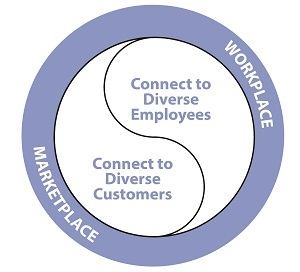ATD Blog
Branding: What Does D&I Have to Do With It?
Wed May 14 2014

We live in times of intense competition—for the best talent, for greater share of market, for customer and employee engagement. The target continues to shift as new innovations, changing requirements and mindsets are altered in a fast changing world. Diversity and inclusion (D&I) plays an increasingly important role, as a consequence of globalization and shifting demographics.
Organizations seek to attract, retain, and develop the best employees, regardless of their place of origin, race or ethnicity, sexual orientation or identity, and other dimensions of diversity, yet long-entrenched biases can get in the way. Similarly, companies must adapt their products, services, and branding to address changing customer tastes, language, culture and diverse preferences.
D&I branding comes into play in a major way, in both the marketplace and the workplace. David Oglivy, often referred to as “the Father of Advertising,” defined a brand as “the intangible sum of product’s attributes.” Oh, how times have changed!
Today, rather than potential employees obtaining messaging about companies from recruiters, they log on to sites like GlassDoor.com or Indeed.com to obtain the insider’s view of how an employer operates, inlcuding the culture, degree of flexibility, career advancement, and other factors.
Customers engage actively with social media as part of the buying decision; we have moved from “the age of the seller,” in which information was packaged, delivered, and controlled by the supplier, to what Jim Blasingame describes in his new book, The Age of the Customer, to an era, in which customers “co-own” brands as “user-generated content” reshapes brand identities.
To be effective, brands have to be consistent and authentic, with an important connection between the workplace and the marketplace. How are employee and customer brand perceptions connected? Social media transparency has effectively eliminated a clear boundary with what organizations are doing internally and their external image. Further, not only are employees a great source as “brand ambassadors,” they can serve as a referral resource to capture desired talent.
When disenfranchised, employees make their views known and tarnish the brand. When companies are found to be conducting themselves in racist or other exclusionary behaviors, it destroys employees’ pride and trust in such organizations, as the fallout from the racist rants of Donald Sterling, owner of the LA Clippers, dramatically illustrates. Likewise, the anti-gay stance of Mozilla’s newly-appointed CEO resulted in his forced resignation.

Simply stated, when the D&I brand celebrates diversity internally and externally, it means that 1) customers will want to buy from you and 2) employees will want to work for you.
Customer and employee branding may be visualized as a “Yin and Yang” connection, interacting in a dynamic balance and interplay.
D&I branding: the good, the bad, and the ugly
Let’s look at a few examples of companies’ D&I brands at different ends of the spectrum.
The good
A recent commercial for Kindle, featuring an attractive man and woman on the beach, offers a light-hearted vignette about sexual orientation.
Consider this charming example from Cheerios, in which a bi-racial family enjoys their cereal, albeit in different ways.
Avanade has created a great example with its YouTube video demonstrating how multiple kinds of diversity are welcomed in this IT services corporation.
The bad
When New York City Police Commissioner Bratton decided to engage with the public with Twitter as part of a social media with the hashtag: #myNYPD, the department was completely blindsided by a negative response, flooded with photos of what appeared to be police brutality.
The ugly
There are too many examples, unfortunately, of blatant sexism, racism and other attitudes being revealed and tarnishing previously beloved brands and personalities; a few can be found in this Forbes.com article.
Steps to take to create a strong D&I brand
Building a strong D&I brand requires executive sponsorship, cross-functional partnerships between HR, marketing, sales, and other functions, as well as input from customers and employees. Here are a few key considerations:
What is our D&I vision and what is its importance to our key internal and external stakeholders?
How do our employees and customers feel about our D&I brand?
What are the best channels we should use for messaging?
Do we obtain ongoing feedback to ensure that our D&I branding is clear, compelling and authentic?
Do different key “touch points” in both the employee lifecycle (such as recruiting, onboarding, development) and in the marketplace (relevant products, delivered effectively across the customer value chain), reinforce and strengthen our brand as a great place to work and do business with?
What does your D&I brand look like? How can it be enhanced to reinforce both employee and customer experiences?
What does your D&I brand look like? How can it be enhanced to reinforce both employee and customer experiences?
To read more D&I blog posts, go to http://www.astd.org/Communities-of-Practice/Human-Capital/Best-Practices-in-Diversity-and-Inclusion.
You've Reached ATD Member-only Content
Become an ATD member to continue
Already a member?Sign In
